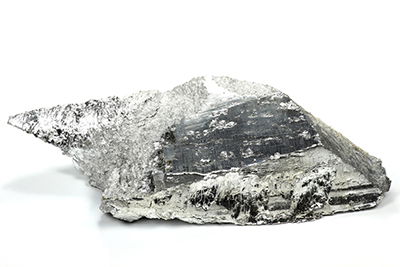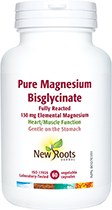Magnificent Magnesium
Magnesium is a mineral that is critically essential for body functioning. It is involved in over 300 cellular reactions in the body—anything and everything such as DNA production, protein synthesis, carbohydrate metabolism, energy production, and cell signaling.[1] It plays a role in antioxidant regeneration, makes bones strong and healthy, modulates pain perception, and helps produce neurotransmitters that keep our brains happy and healthy.[2] In short, magnesium is needed for almost every aspect of bodily functioning, and a relative deficiency of magnesium affects almost everything as well.
 Low levels of magnesium are associated with an increased risk of chronic conditions such as osteoporosis, high blood pressure, cardiovascular disease and stroke, diabetes, metabolic syndrome, and obesity.[3] People with lower‑than‑optimal magnesium levels seem to be more often affected by anxiety, depression, and headaches, especially migraine headaches, and women may experience worse PMS and menstrual cramps. Low serum magnesium also appears to be associated with worsened inflammation and increased pain sensitivity, thus making even minor injuries feel worse.[4]
Low levels of magnesium are associated with an increased risk of chronic conditions such as osteoporosis, high blood pressure, cardiovascular disease and stroke, diabetes, metabolic syndrome, and obesity.[3] People with lower‑than‑optimal magnesium levels seem to be more often affected by anxiety, depression, and headaches, especially migraine headaches, and women may experience worse PMS and menstrual cramps. Low serum magnesium also appears to be associated with worsened inflammation and increased pain sensitivity, thus making even minor injuries feel worse.[4]
As stated in a recent study with an urgent call to action, subclinical magnesium deficiency is a principal driver of cardiovascular disease and should be considered a public health crisis.[5] Studies suggest ensuring adequate magnesium intake improves one’s cardiovascular health, including lowering blood pressure and reducing complications following heart attack or stroke. Magnesium supplementation also appears to improve insulin sensitivity in type 2 diabetes, thus improving glucose control and long-term outcomes.[6]
It may also play a role in reducing the frequency and severity of osteoporosis (brittle bones) often associated with aging.
Mental‑health conditions and sleep quality are improved, as adequate magnesium levels allow for optimal neurotransmitter production. Additionally, supplementation appears to reduce cortisol (a stress hormone) and reduce inflammation and modulating pain, thus improving overall health and wellbeing.[7]
 Improving magnesium status from one of deficiency to adequacy may also reduce the frequency and severity of asthma attacks, by opening the air passages of the lungs.[8] Magnesium also appears to have an anticonvulsant and neuroprotective effect, and it can reduce the frequency and severity of migraine headaches.[9]
Improving magnesium status from one of deficiency to adequacy may also reduce the frequency and severity of asthma attacks, by opening the air passages of the lungs.[8] Magnesium also appears to have an anticonvulsant and neuroprotective effect, and it can reduce the frequency and severity of migraine headaches.[9]
But the conditions associated with low magnesium are incredibly common: How do we know when magnesium plays a role? Unfortunately, it is a bit of a guessing game. There is no easy or reliable test to conclusively determine someone’s magnesium status.[10] Low magnesium levels are usually asymptomatic or show up with the above nonspecific symptoms. The best way to prevent low levels is to ensure you get an adequate daily intake of magnesium. Doing so through diet alone is not an easy task, so supplementation can be the key.[11]
So, how much magnesium do we need? It depends upon age and gender, but on average, 400 to 420 mg per day is recommended for males over the age of 14 years, and 310 to 360 mg per day for females over the age of 14, with no more than 350 mg magnesium from supplementation per day (unless prescribed otherwise by a physician or health-care practitioner).[12], [13]
Magnesium is currently considered a “shortfall micronutrient” because, despite it being available in many foods, we are simply not getting enough of it.[14] It is estimated that 50% of the US adult population consumes insufficient amounts of dietary magnesium, and up to 30% of the general population may in fact be deficient.[15], [16]
To make matters worse, many common medications can also deplete magnesium levels in the body—certain types of antibiotics, antifungal medications, corticosteroids and other immunosuppressive medications, high-blood-pressure medications, oral contraceptives (especially those containing estrogen), and proton-pump inhibitors, to name a few. Furthermore, people with digestive issues or kidney diseases, as well as those who are elderly or consume alcohol regularly, are at increased risk of deficiency.[17]
Food sources of magnesium typically include high-fibre foods: legumes, nuts, seeds, leafy greens, and whole grains.[18], [19] There are excellent resource tables available online from Health Canada and Dieticians of Canada that show the magnesium content of certain foods,[20], [21] yet getting enough seems easier said than done. When inadequate magnesium amounts are obtained from one’s diet alone—or when health situations require more magnesium—what supplement options are out there?
 The first thing to note is that magnesium is a mineral, an element—it cannot be consumed on its own. It must be bound to something else—another molecule or compound—for our bodies to be able to absorb it. There are a wide variety of magnesium compounds out there (also known as “chelates”), each offering different absorptive effects. Additionally, the carrier molecules have different effects in the body. In short, it is not so simple as to take some “magnesium”: You must consider the form it is in and match that form to your health concerns.
The first thing to note is that magnesium is a mineral, an element—it cannot be consumed on its own. It must be bound to something else—another molecule or compound—for our bodies to be able to absorb it. There are a wide variety of magnesium compounds out there (also known as “chelates”), each offering different absorptive effects. Additionally, the carrier molecules have different effects in the body. In short, it is not so simple as to take some “magnesium”: You must consider the form it is in and match that form to your health concerns.
Magnesium Citrate
A very common form of magnesium which is widely available and middle-of-the-road in cost is magnesium citrate. It is bound to citrate, or citric acid, an organic acid, and has a dose-dependent laxative effect. This form of magnesium absorbs at a decent level—not the least and not the best. Therefore, magnesium citrate is typically used by folks affected by constipation and who want to increase their magnesium levels a bit.
Magnesium Glycinate or Bisglycinate
Another very common magnesium chelate is magnesium glycinate or bisglycinate. These two names both refer to magnesium bound to the amino acid glycine. It offers minimal digestive side effects, as the glycine molecule appears like food to the body. The primary benefit of this form is that it can be dosed higher than most other magnesium chelates, thus resulting in adequate magnesium absorption without digestive side effects.
Magnesium Orotate
Magnesium orotate is a less common magnesium chelate, with magnesium being bound to orotic acid. Orotic acid is thought to have cardiac benefits and may help deliver magnesium more specifically to the heart than other forms of magnesium.[22] This form has started gaining popularity and is more readily available.
Magnesium ʟ‑Threonate
Magnesium ʟ‑threonate is an increasingly popular magnesium chelate, thought to target the brain and improve memory and brain function. ʟ‑Threonate is a metabolite of vitamin C that appears to easily cross the blood-brain barrier. It is thought that magnesium bound to ʟ‑threonate will enter the brain more easily than other forms, thus providing targeted brain benefits, more so than other forms of magnesium.[23], [24]
To summarize, a wide variety of health conditions associated with low magnesium may be improved with ensuring adequate magnesium intake. Sufficient amounts of magnesium can be difficult to obtain through diet alone, especially the standard American diet. Supplemental magnesium offers a solution to this, but there are several different forms available, and each has its own additional health benefits. If you are thinking to take magnesium to supplement your diet, be sure to check with your health-care practitioner to select the type that is best for your health conditions.
Magnesium Ascorbate
A similar form to magnesium citrate is magnesium ascorbate. Ascorbate is a buffered form of vitamin C which is nonacidic and gentler on the stomach than ascorbic acid. Magnesium in this form appears to absorb decently well and offers the combined benefits of vitamin C and magnesium.
Magnesium Malate
Magnesium malate—magnesium bound to malic acid—is commonly used by people affected by fibromyalgia. Magnesium appears to modulate pain, especially neurogenic pain, while malic acid helps improve energy production on a cellular level. Combined, magnesium malate, taken over the long term, may help reduce fibromyalgia pain severity.[25] It is also a popular product in sport nutrition as it supports more specifically muscles.
Magnesium Aspartate
Magnesium aspartate is another amino-acid chelate—magnesium bound to aspartic acid.[26] It is less common that magnesium bisglycinate but offers similar high absorption and solubility. It is thought to help improve magnesium levels, and the addition of aspartic acid may help reduce muscle fatigue.
Magnesium Taurate
Magnesium taurate, another less common magnesium chelate, is magnesium bound to taurine, an amino acid. Taurine is thought to improve cardiac function and have a calming effect, and it may help reduce blood pressure.
Magnesium Glycerophosphate
Magnesium glycerophosphate is uncommonly available but may have significant health benefits with minimal side effects. It is a patented form of magnesium bound to glycerophosphate, a molecule that itself appears to have independent health benefits.[27] It appears to be primarily used in prescription form, for people with diagnosed low levels of magnesium.[28]
Magnesium Salts
Several other forms of magnesium used medicinally include magnesium sulfate, magnesium oxide, magnesium carbonate, magnesium hydroxide, and magnesium tricilate. Magnesium sulfate is typically given intravenously in medical settings, such as for preeclampsia and seizures.[29] The other four are taken orally and react with stomach acid to produce an antiacid effect. Magnesium from these compounds is minimally absorbed, if at all, and the resulting magnesium load has an osmotic effect in the digestive system, creating a laxative effect. In short, these forms of magnesium are typically used by folks experiencing heartburn and indigestion related to stomach acidity who do not want magnesium to be systemically absorbed.
 Dr. Katie DeGroot, BSc, ND, MScN
Dr. Katie DeGroot, BSc, ND, MScN
Dr. DeGroot is an Alberta-registered naturopathic doctor who also holds a Master of Science in Nutrition. She offers nutritionally focused care and has a special interest in digestive issues and supportive mental health-care.
drkatiedegroot.ca
References
[1] Higdon, J., V.J. Drake, B. Delage, and S.L. Volpe. “Magnesium.” Linus Pauling Institute. Micronutrient Information Center. https://lpi.oregonstate.edu/mic/minerals/magnesium · 2001–2019. · Accessed 2022‑07‑06.
[2] Higdon et al. “Magnesium.”
[3] Higdon et al. “Magnesium.”
[4] Higdon et al. “Magnesium.”
[5] DiNicolantonio, J.J., J.H. O’Keefe, and W. Wilson. “Subclinical magnesium deficiency: A principal driver of cardiovascular disease and a public health crisis.” Open Heart, Vol. 5, No. 1 (2018): e000668.
[6] Higdon et al. “Magnesium.”
[7] Higdon et al. “Magnesium.”
[8] Higdon et al. “Magnesium.”
[9] Higdon et al. “Magnesium.”
[10] Higdon et al. “Magnesium.”
[11] UnlockFood.ca. “What you need to know about magnesium.” https://www.unlockfood.ca/en/Articles/Vitamins-and-Minerals/What-you-need-to-know-about-magnesium.aspx · Updated 2019‑03‑21. · Accessed 2022‑07‑06.
[12] UnlockFood.ca. “What you need to know about magnesium.”
[13] Canada.ca. “Dietary reference intakes.” https://www.canada.ca/en/health-canada/services/food-nutrition/healthy-eating/dietary-reference-intakes/tables/reference-values-elements-dietary-reference-intakes-tables-2005.html · Updated 2006‑06‑29. · Accessed 2022‑07‑11.
[14] Higdon et al. “Magnesium.”
[15] Higdon et al. “Magnesium.”
[16] Hruby, A., and N.M. McKeown. “Magnesium deficiency: What is our status?” Nutrition Today, Vol. 51, No. 3 (2016): 121–128.
[17] Higdon et al. “Magnesium.”
[18] Higdon et al. “Magnesium.”
[19] UnlockFood.ca. “What you need to know about magnesium.”
[20] UnlockFood.ca. “What you need to know about magnesium.”
[21] Canada.ca. “Dietary reference intakes.”
[22] Landry, G. “Magnesium: The mineral panacea.” New Roots Herbal: Flourish blog. https://newrootsherbal.com/en/blog/health/magnesium-the-mineral-panacea · 2021‑08‑09. Accessed 2022‑07‑12.
[23] Landry, G. “Magnesium : The mineral panacea.”
[24] Patel, K. “L‑Threonate.” Examine.com. https://examine.com/supplements/l-threonate/research/ · Updated 2022‑09‑28.
[25] Landry, G. “Magnesium : The mineral panacea.”
[26] Drug Bank Online. “Magnesium aspartate.” https://go.drugbank.com/drugs/DB13359 · Posted 2017‑06‑23. · Updated 2020‑11‑03. · Accessed 2022‑07‑06.
[27] Isaltis.com. “Givomag (magnesium glycerophosphate).” https://www.isaltis.com/en/our-products/magnesium/givomag/ · Accessed 2022‑07‑06.
[28] Healthcare Improvement Scotland. Scottish Medicines Consortium. “Magnesium glycerophosphate (Neomag).” https://www.scottishmedicines.org.uk/medicines-advice/magnesium-glycerophosphate-neomag-abbreviatedsubmission-126717/ · Published 20170911. · Accessed 2022‑07‑06.
[29] Higdon et al. “Magnesium.”

 Stores
Stores








